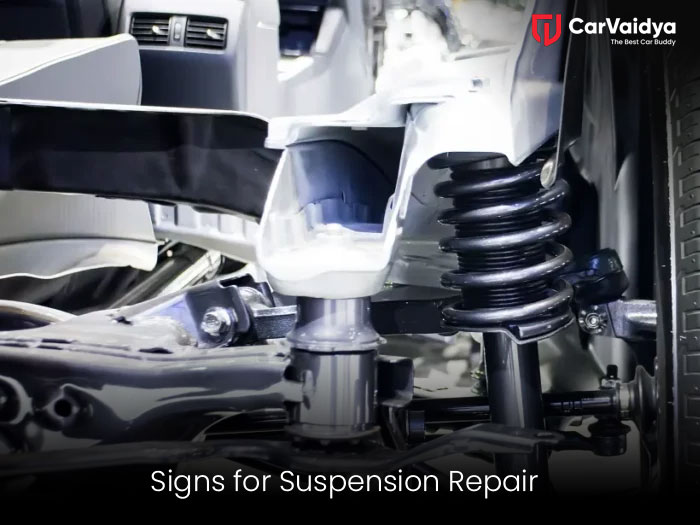4 Signs Your Car Needs Suspension Repair

 By CarVaidya
By CarVaidya- 29 Mar 2024
4 Signs Your Car Needs Suspension Repair
Your car's suspension system plays a crucial role in ensuring a smooth and comfortable ride while also maintaining stability and control. Over time, wear and tear can occur, leading to various issues that may compromise your vehicle's performance, safety, and comfort. Recognizing the signs that your car needs suspension repair is essential for addressing problems early and preventing further damage. In this guide, we'll explore four common signs indicating suspension issues, along with explanations of the underlying problems and potential solutions.
Uneven Tire Wear
One of the most noticeable signs of suspension problems is uneven tire wear. When your suspension system is compromised, it can cause your tires to wear unevenly, resulting in bald spots, cupping, or other irregular patterns. Uneven tire wear is often indicative of issues such as misaligned wheels, worn-out shocks or struts, or damaged suspension components.
Cause
Several factors can contribute to uneven tire wear in vehicles with suspension issues. Misaligned wheels can exert uneven pressure on the tires, causing them to wear prematurely. Worn-out shocks or struts may fail to properly dampen vibrations and impacts, leading to increased tire wear. Additionally, damaged suspension components such as control arms or bushings can cause misalignment and uneven tire contact with the road surface.
Solution
To address uneven tire wear caused by suspension problems, a thorough inspection of the suspension system is necessary. A qualified mechanic can check for worn-out shocks or struts, damaged components, and wheel misalignment. Depending on the severity of the issue, repairs may involve replacing worn-out parts, realigning the wheels, or correcting suspension geometry. Regular tire rotations and wheel alignments can also help prevent uneven tire wear and prolong the lifespan of your tires.
Excessive Bouncing or Swaying
If you notice that your car bounces excessively over bumps or dips in the road, or if it sways excessively during turns or lane changes, it could be a sign of suspension trouble. A healthy suspension system should provide a smooth and stable ride, absorbing impacts and maintaining control over the vehicle's movements. Excessive bouncing or swaying indicates a loss of suspension damping and stiffness, which can compromise handling and safety.
Cause
Excessive bouncing or swaying can be attributed to several underlying issues within the suspension system. Worn-out or leaking shocks or struts are common culprits, as they may no longer provide sufficient damping force to control the vehicle's motion. Weak or broken springs can also contribute to excessive bouncing, as they are responsible for supporting the weight of the vehicle and maintaining ride height. Additionally, worn bushings or other suspension components can allow excessive movement and instability.
Solution
To address excessive bouncing or swaying, a comprehensive inspection of the suspension system is necessary. A mechanic will check for signs of worn-out shocks or struts, leaking fluids, broken springs, and damaged components. Depending on the diagnosis, repairs may involve replacing worn-out shocks or struts, installing new springs, or repairing damaged components. Upgrading to high-performance suspension components may also improve ride quality and handling characteristics.
Knocking or Clunking Sounds
Strange noises coming from your car's suspension system, such as knocking, clunking, or rattling sounds, are often indicators of underlying issues that require attention. These noises typically occur when driving over bumps, uneven road surfaces, or during maneuvers such as turning or braking. Ignoring these sounds can lead to further damage to suspension components and compromise vehicle safety.
Cause
Knocking or clunking sounds in the suspension system can stem from various sources, including worn-out or damaged components. Loose or worn-out ball joints, control arms, or stabilizer bar links can produce knocking noises when they move or shift out of position. Damaged or deteriorated bushings can also cause similar sounds as they allow excessive movement and play in the suspension components. Additionally, worn-out shocks or struts may produce clunking noises as they bottom out or fail to dampen vibrations effectively.
Solution
Diagnosing and addressing knocking or clunking sounds in the suspension system require a systematic approach. A qualified mechanic will perform a visual inspection of suspension components to identify any visible signs of damage or wear. They may also conduct a road test to replicate the symptoms and pinpoint the source of the noises. Depending on the findings, repairs may involve replacing worn-out or damaged components, tightening loose fasteners, or lubricating bushings to reduce friction and noise.
Steering Responsiveness Issue
A well-functioning suspension system is essential for maintaining precise steering control and responsiveness. If you experience difficulties steering your car, such as excessive play in the steering wheel, delayed response to steering inputs, or a drifting sensation while driving straight, it could indicate suspension problems. These symptoms can affect handling and maneuverability, posing safety risks on the road.
Cause
Steering responsiveness issues can arise from various suspension-related issues that affect wheel alignment, stability, and control. Worn-out or damaged steering components such as tie rods, ball joints, or rack and pinion assemblies can cause excessive play in the steering system, leading to a lack of responsiveness and precision. Misaligned wheels, caused by worn-out suspension components or improper adjustments, can also affect steering behavior and induce drifting or pulling sensations while driving.
Solution
Addressing steering responsiveness issues requires a thorough inspection of the suspension and steering systems to identify the root cause of the problem. A qualified mechanic will check for worn-out or damaged steering components, wheel alignment issues, and suspension-related problems affecting stability and control. Depending on the diagnosis, repairs may involve replacing worn-out parts, realigning the wheels, or correcting suspension geometry to restore proper steering responsiveness and handling characteristics.
Maintaining a healthy suspension system is crucial for ensuring a safe, comfortable, and enjoyable driving experience. By recognizing the signs of suspension problems and addressing them promptly, you can prevent further damage, improve vehicle performance, and enhance safety on the road. If you notice any of the signs mentioned, such as uneven tire wear, excessive bouncing or swaying, strange noises, or steering responsiveness issues, it's essential to have your car inspected by a qualified mechanic. With timely maintenance and repairs, you can keep your suspension system in top condition and enjoy smoother rides for miles to come.
You can read some other articles
Top 5 things to check before buying a used in India
10 easiest tips to clean your car’s interior
Unlocking the best car service deals in Delhi with CarVaidya: A step-by-step guide




0 Comments